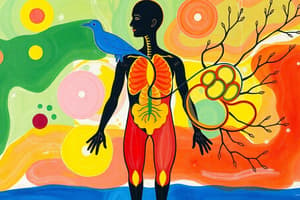Podcast
Questions and Answers
Explain how shivering helps regulate body temperature.
Explain how shivering helps regulate body temperature.
Shivering is a process that generates heat by rapidly contracting muscles, which raises body temperature back to normal levels when it drops too low.
What happens when the body temperature rises too high due to shivering?
What happens when the body temperature rises too high due to shivering?
When the body temperature rises too high due to shivering, the body triggers sweating, which helps cool the body down by evaporating moisture from the skin.
How does the nervous system play a role in regulating body temperature?
How does the nervous system play a role in regulating body temperature?
The nervous system receives information about body temperature from receptors and transmits it to the brain, which then sends signals to muscles to shiver or sweat, regulating body temperature.
Why is homeostasis essential for survival?
Why is homeostasis essential for survival?
What are the potential consequences of dysregulation of homeostasis?
What are the potential consequences of dysregulation of homeostasis?
What is homeostasis and why is it essential for the proper functioning of cells?
What is homeostasis and why is it essential for the proper functioning of cells?
Describe the three main components of an automatic control system involved in homeostasis.
Describe the three main components of an automatic control system involved in homeostasis.
Explain the role of the nervous system in communication within the body, highlighting its key characteristics.
Explain the role of the nervous system in communication within the body, highlighting its key characteristics.
What are hormones, and how does the endocrine system differ from the nervous system in terms of communication?
What are hormones, and how does the endocrine system differ from the nervous system in terms of communication?
Describe negative feedback and explain how it works in maintaining homeostasis.
Describe negative feedback and explain how it works in maintaining homeostasis.
Explain how the body regulates temperature when exposed to cold temperatures. Use the example of a person entering a cold room.
Explain how the body regulates temperature when exposed to cold temperatures. Use the example of a person entering a cold room.
Give an example of how the endocrine system plays a role in maintaining homeostasis.
Give an example of how the endocrine system plays a role in maintaining homeostasis.
What are the potential consequences of failing to maintain homeostasis? Give at least two examples.
What are the potential consequences of failing to maintain homeostasis? Give at least two examples.
Flashcards
Nervous System
Nervous System
System that transmits signals to and from the brain.
Shivering
Shivering
Involuntary muscle contractions to generate heat and raise body temperature.
Sweating
Sweating
Process that cools the body when temperature rises too high.
Negative Feedback
Negative Feedback
Signup and view all the flashcards
Homeostasis
Homeostasis
Signup and view all the flashcards
Receptors
Receptors
Signup and view all the flashcards
Coordination Centers
Coordination Centers
Signup and view all the flashcards
Effectors
Effectors
Signup and view all the flashcards
Endocrine System
Endocrine System
Signup and view all the flashcards
Temperature Regulation
Temperature Regulation
Signup and view all the flashcards
Study Notes
Homeostasis: Maintaining a Stable Internal Environment
- Homeostasis is the process of maintaining a stable internal environment within the body, despite changes in both internal and external conditions
- This stable environment is crucial for the proper functioning of cells, which require specific conditions such as optimal temperature, pH, and nutrient levels
- Homeostasis involves regulating various factors like body temperature, glucose levels, water balance, and others, ensuring they stay within a healthy range
- The body utilizes automatic control systems to achieve homeostasis, which consist of three main components:
Components of Automatic Control Systems
- Receptors: These detect changes in the internal environment, such as a rise in body temperature or a drop in blood glucose levels.
- Coordination Centers: These interpret the signals received from the receptors and decide on an appropriate response. Examples include the brain and spinal cord.
- Effectors: These carry out the response decided by the coordination center. They can be muscles that contract (e.g., shivering) or glands that release hormones.
Communication Within the Body: The Nervous and Endocrine Systems
- To communicate signals between the different components of automatic control systems, the nervous system and endocrine system work collaboratively.
- The nervous system transmits rapid, precise electrical impulses through nerves, enabling quick responses to stimuli like touching a hot object.
- The endocrine system relies on hormones, chemical messengers that travel via the bloodstream. While hormones reach all cells, they only have an effect on those with specific receptors for that particular hormone.
- The endocrine system is generally slower, longer-lasting, and more generalized than the nervous system.
Negative Feedback: The Mechanism of Homeostasis
- Negative feedback is a crucial mechanism that allows the body to maintain homeostasis.
- When levels of a regulated factor rise above a certain threshold, negative feedback mechanisms work to decrease them back to the normal range.
- Conversely, when levels fall below a certain threshold, negative feedback mechanisms work to increase them back to the normal range.
- This process essentially creates a loop where the body constantly monitors and adjusts itself to maintain a steady state.
Example: Temperature Regulation
- Imagine walking into a cold room. Receptors in the skin detect the low temperature.
- The nervous system transmits this information to the brain, which then sends signals to muscles to start shivering.
- Shivering generates heat, raising the body temperature back to normal levels.
- If the body temperature rises too high due to excessive shivering, receptors detect this increase and trigger sweating, which helps cool the body down.
- This constant back-and-forth adjustment, driven by negative feedback, maintains a stable body temperature despite external changes.
The Importance of Homeostasis
- Homeostasis is essential for survival as it allows the body to function and thrive in changing environments.
- It ensures cells have the optimal conditions they need to perform their functions properly.
- Dysregulation of homeostasis can contribute to various health problems and diseases.
Studying That Suits You
Use AI to generate personalized quizzes and flashcards to suit your learning preferences.




